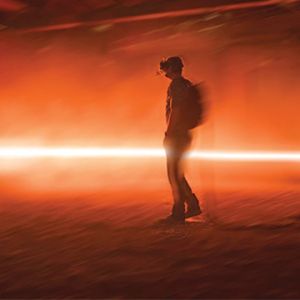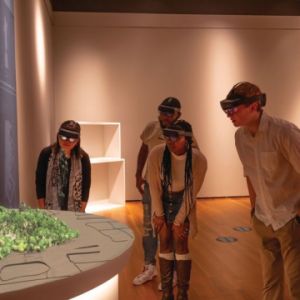
Museum professionals would be wise to see immersive experiences as a beginning, not an end.
This article originally appeared in the November/December 2022 issue of Museum magazine, a benefit of AAM membership.
The past two years have seen an explosion of visitor attractions and museum experiences that have highlighted their “immersive” nature. In 2021, there were dozens of different digital technology-based “immersive experiences” on offer in the United States alone. Corey Ross of Lighthouse Immersive, the company responsible for a dozen of the almost 50 immersive Van Gogh shows touring the US, said his company sold 4.5 million tickets through the end of 2021, generating roughly $250 million in revenue.
I’ve been making visitor experiences in museums for over 30 years, and I’ve watched the explosive growth of this industry with equal amounts of interest and dread. I’m interested in how people are experimenting with engagement, and I dread the way the museum community has largely missed the potential that these immersive experiences hint at. Museum and cultural professionals have spilled far too much ink debating whether these immersive experiences count as “authentic” art experiences and not nearly as much wondering why millions of Americans are deciding they’d like to spend their free time in an immersive environment and are choosing not to go to a museum to do it.
The Immersive Landscape Today
Millions of Americans are spending time and money at experiences devoted to “name brand” artists like Van Gogh, Klimt, Kahlo, Michelangelo, Monet, and others. Why not “Immersive Caillebotte” or “Crivelli: The Immersive Experience”? If visual immersion were the only determining factor, then one gigantic image is much like the next.
I think visitors want an aesthetic experience and are using the known members of the Western art canon as a proxy for quality. They are motivated by a desire for a restorative experience, a type of visitor identity learning expert John Falk calls “rechargers” or “spiritual pilgrims.” And while one strand of the current immersive experience is the “dead artist whose artwork is in the public domain,” there is also a separate trend: large-scale, artist-led immersive experiences that create new experiential art.
For example, teamLab, an interdisciplinary, international art collective whose practice navigates the intersections of art, science, technology, and the natural world, has been conceiving and developing large-scale digital immersive installations for over 20 years. These experiences not only overwhelm the senses but also allow visitors to interact with the environment. In “Catching and Collecting Forest” at teamLab Forest Fukuoka in Japan, visitors can interact with the digital images of animals that roam the space. They can also use a smartphone app to “capture” animals for study, removing them from the environment as they appear on the visitor’s phone. When they’re done, they can return their animal to the larger environment.
Similarly, Santa Fe–based Meow Wolf, another artist collective, aims to inspire creativity through art, exploration, and play so that imagination can transform our worlds. Since 2016 Meow Wolf has been creating gigantic physical environments that encourage exploration and interactive storytelling. “Convergence Station,” their third permanent exhibition, opened in Denver in 2021. This 90,000-square-foot installation introduces visitors to the “Quantum Department of Transportation” and allows them to enter multiple immersive environments as they explore city streets, alien worlds, and giant sentient plants. Throughout their time at Convergence Station, they can also explore a mystery story about four forgotten women and a mythical gateway to the infinite.
The Hallmarks of Immersion

Immersion is clearly having a moment in both digital and physical terms, but what is it about immersion that is so compelling? In her seminal work “Hamlet on the Holodeck,” media theorist Janet Murray defined sensory immersion as “a metaphorical term derived from the physical experience of being submerged in water. We seek the same feeling from a psychologically immersive experience that we do from a plunge in the ocean or swimming pool: the sensation of being surrounded by a completely other reality, as different as water is from air, that takes over all our attention, our whole perceptual apparatus.”
Entering an immersive experience is akin to diving into a pool. All your senses are activated as your brain attempts to understand what’s happening. Immersion also requires two environments that are substantially, noticeably different. We are always immersed in whatever environment we are in. But just as it’s hard for fish to see the water they swim in; we take our default environment for granted once we understand the rules.
Immersion is, in one sense, the act of transitioning between environments and being aware of the transition. This distinction is critically important to us as experience designers. As Seb Chan, Director of the Australian Centre for the Moving Image, says, “Immersion matters to create a distinction between the outside world and inside the exhibition, a magic circle where visitors gain superpowers.”
Three factors encourage and sustain that sense of immersion: attention, intrinsic motivation, and agency.
Attention
Psychologist Daniel Kahneman has proposed a model of how our brains process incoming information, arguing that we employ two attention systems: System 1, which is fast and intuitive and requires little effort, and System 2, which is slow and logical and requires conscious effort. We have evolved to process as much of our world as possible using System 1 so we can save our finite brainpower for situations that require it. Walking down a familiar street is an example of System 1 thinking. You don’t have to think about it, you just do it. Locating your friend’s face in a crowd? That requires System 2.
Immersion triggers a shift in how we pay attention. In terms of Kahneman’s model, Attention System 1 stops, and System 2 takes over as our brains try to answer the questions “Where am I?” and “What new rules apply?” The bewildering environment of an immersive experience, with things happening on every surface around us, makes us pay attention in a way we don’t in a familiar setting like home, work, or a museum. “Immersive Van Gogh” and its competitors do a great job of grabbing visitors’ attention, though it’s arguable how well they hold that attention.
Intrinsic Motivation
This should come as little surprise to museum professionals, but visitors’ intrinsic motivation plays a large role in whether an experience feels immersive or not. Samuel Coleridge described what readers of literature do as the “suspension of disbelief.” Murray reframes that notion and argues that what people engage in is the “active creation of belief.” Because we want to feel immersion, we focus our attention on reinforcing our perceived reality of the experience.
This is why low-resolution virtual environments can feel immersive, even though their appearance is objectively simpler than reality. We fill in the gaps with our imagination.
Agency
The agency visitors possess to navigate and interact with the environment is important. Since part of the immersive experience is the transition from the default environment to the new one, the metaphor of “visiting,” with all its associations with self-directed travel and foreignness, helps promote a feeling of agency, what Murray calls “the satisfying power to take meaningful action and see the results of our decisions and choices.”
I have often witnessed visitors in projection-based immersive experiences use their bodies to try to interact with the image, holding up a hand to see if anything changes as a result. In the case of most commercial experiences, the answer is no, but just moving around the space, and seeing how the view changes as you move, can be pleasant. But there could be so much more.
Immersion as a Beginning
A lot of the criticism leveled at immersives boils down to “they don’t teach visitors anything.” Whether that’s a valid critique is a whole other question, but behind that critique is a feeling that an opportunity is being squandered. Motivated, attentive visitors aren’t being given opportunities to satisfy all of their desires.
I’ve always thought of immersion as a gateway to deeper engagement, not an end unto itself, but struggled to put a theoretical framework around that feeling until I came across game scholar Mark Wolf’s work on immersion. Wolf describes a continuum of engagement where immersion is only the first of four levels of potential engagement a person might have with the imaginary worlds game designers and authors create:
- Immersion: the process of transitioning between distinct environments and being aware of the transition.
- Absorption: the act of having your attention and imagination pulled into the imaginary world of the experience so that you mentally leave, or at least block out, your physical surroundings.
- Saturation: the state of having your full attention, concentration, and imagination occupied, often with more detail, nuances, and subtleties than can be held in mind all at once.
- Overflow: the satisfying realization that the imaginary environment is just too big, and you can never hold the experience entirely in your mind.
The idea that immersion is not an end but a potential beginning for engaging visitors is powerful. Let’s look at three recent immersive exhibitions that show how museums are experimenting with this continuum of engagement.
In “Revealing Krishna,” created by the Cleveland Museum of Art, a traditional museum exhibition is combined with immersive video and headset-based mixed reality to explore a Cambodian statue of the god Krishna and give visitors a sense of its original home in the temple of Phnom Da. Rather than relying solely on immersion, the museum has carefully chosen to augment its modes of display. Visitors can dip in and out of different immersive moments while having a traditional object-focused experience.

HoloLens headsets to view a mixed-reality scene.
“Carne y Arena (Virtually Present, Physically Invisible),” a hybrid physical/virtual immersive experience by movie director Alejandro Iñárritu, has been featured at multiple museums since its creation in 2017. A visceral exploration of migration across the US southern border, it creates its immersion by blending a VR narrative with a real physical environment that reinforces the feeling of being in the desert. Visitors can view an unfolding story of an encounter between migrants and law enforcement officers from any vantage point they choose as they move around the space. After the immersive VR experience, visitors enter a final gallery where they learn more about the issue and the people they saw in the immersive gallery. The immersion is used to prime visitors for a physical absorption experience.
“Connected Worlds” at the New York Hall of Science is a large-scale interactive ecosystem composed of six different habitats, connected by an interactive floor and a 45-foot-high digital waterfall. Visitors can not only inspect the space but can reshape the environments through their actions. This exhibition immerses viewers in its world and teases them with glimpses of ways they can interact with and change the world. Some seeds can be “caught” and planted, causing new plants to grow. Physical logs can be moved around the floor to divert projected water flow into the habitats, causing plants and animals to grow and thrive. The exhibition immerses and absorbs visitors as they experiment and discover the limits of their agency. Interacting with the space increases visitors’ interest in the content and the amount of time they devote to the experience. I would argue it comes close to saturating those visitors who engage with it.
What kinds of experiences might we design if we took Wolf’s model to heart? Wolf draws his examples from the worlds of game design and television, where tools like story bibles—compendia of all the characters, objects, and plot lines of the story world—are essential resources to the teams of people creating the experience.
What would your next exhibition look like if you conceived it as a story world within which visitors were able to climb the engagement ladder that begins with immersion? Where might we take visitors if immersion were only the first step of that journey rather than the endpoint?









Comments